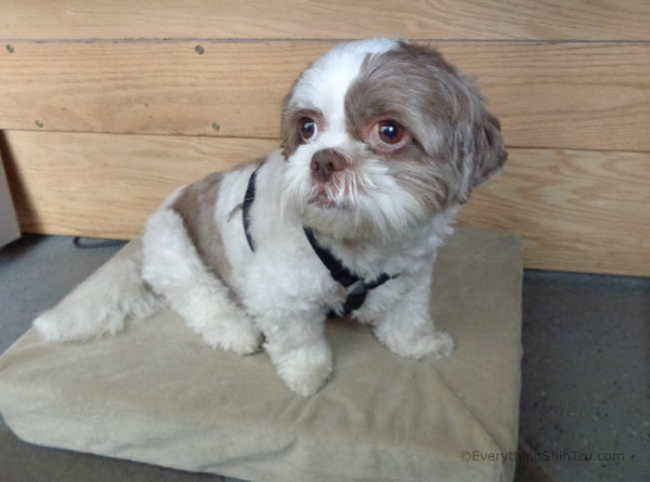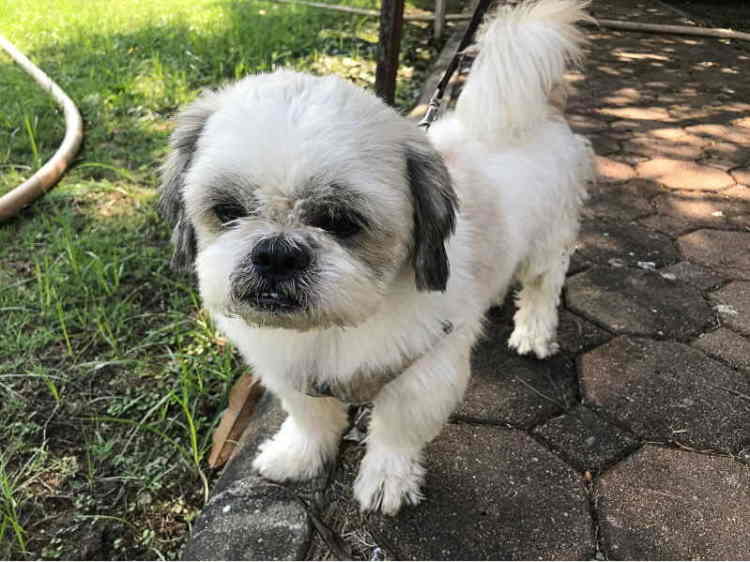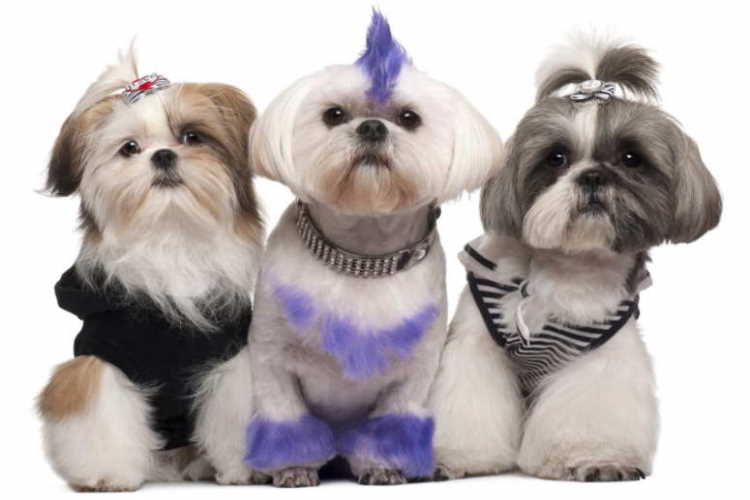Shih Tzu Eye Problems Prevention and Treatment Tips
WRITTEN BY MOLLY | EVERYTHINGSHIHTZU.COM
As it is said, the eyes are a window to the soul. And when looking into the eyes of a Shih Tzu you will undoubtedly see love.
But sometimes you will see something just isn't right.
Shih Tzu eye problems are not uncommon. Unfortunately, these problems cause discomfort, irritations and in some extreme circumstances, vision loss.
However, with attention and care on a daily basis, you can recognize many of the symptoms before it develops into a serious issue.
 Shih Tzu Eye Problems - Tear Stains
Shih Tzu Eye Problems - Tear StainsThe distinctly protruding eyes of a Shih Tzu are prone to irritation caused by dirt, dust or even pollen if the dog suffers from seasonal allergies, in addition to being vulnerable to external injuries from table corners to cat's claws.
While all dogs eyes should be periodically inspected and cleaned if necessary, the Shih Tzu's eyes need to be cleaned every day.
Excessive bulging of the eyes causes continuous watering that can provide an excellent breeding ground for bacteria.
Inflammation of the cornea can also occur as a result of the Shih Tzu having shallow eye sockets and extremely flat noses.
This type of skull formation inhibits proper closure of the eyelids.
Keeping hair around his eyes trimmed so that it does not touch or lay on the eyeballs is also important in preventing irritation which can cause excessive tearing and pawing at their eyes for relief.
Symptoms of eye problems which need immediate attention are:
- cloudiness in the eye
- excessive or greenish colored discharge
- sensitivity to bright lights
- swelling around the eye
- "pawing" the eyes and shaking the head
If your dog exhibits any of these symptoms what may seem insignificant can sometimes get worse in a short amount of time leading to severe and/or permanent eye damage.
Specific Shih Tzu Eye Problems
Warning: the images below may be disturbing to some viewers. Viewer discretion is advised.
Cataracts

Developing cataracts commonly happens to older Shih Tzu who are at least seven or eight years old.
Cataract growth is genetically inherited in pure bred Shih Tzu and cause a white film to cover the eye, eventually causing blindness when left untreated.
To remove these cataracts, surgery is implemented usually with successful results.
Although this operation will remove the chance of blindness, he may subsequently experience a slight reduction in vision.
Unfortunately you can't really prevent cataracts but you may be able to slow the progression with a good healthy diet and avoidance of toxins.
Corneal Ulcer
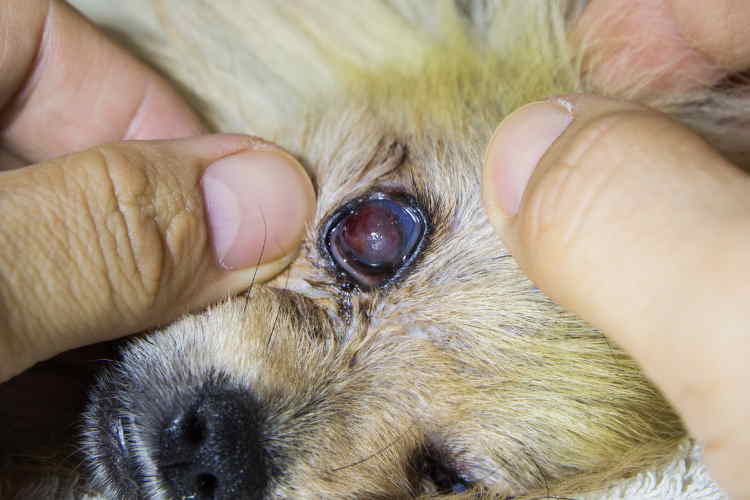
Corneal ulcers are painful and you may notice that your dog is squinting, pawing, or rubbing at the eye.
Due to their protruding eyes, a corneal ulcer generally develops as the result of an injury to the eye, such as a scratch deep enough to allow the cornea to be exposed.
Because these scratches are not always visible, you may not know your sweet little dog is experiencing an ulcer on their cornea.
Although some ulcers may go unnoticed, if you notice a small round spot on his eye that may be slightly discolored, this is a good indication that it is an ulcer.
However if you begin to notice:
- excessive tearing
- frequently closing eyes
- seems hesitant to blink
- leaves eyelids half-closed over the eye, squinting
All these are indications that your dog may be suffering from a corneal ulcer which causes pain when touched by the inside of the eyelid.
The treatment, if not severe, will likely be daily doses of prescription eye drops until the tear has healed.
If the ulcer is severe, your may notice your sweet little dog behaving with a little more aggression than your used to when you try to give them eyedrops.
Should that happen don't take it personally, your dog is trying to protect himself from more pain.
It would best to seek veterinary attention the next day if not sooner for a thorough eye exam.
Superficial ulcers aren’t typically visible to the naked eye. Upon the examination your vet will use a stain called "fluorescein" that sticks to the ulcer and turns it a fluorescent green making it visible.
The Veterinarian can then determine the best coarse of action.
Since ulcers can be caused in many different ways, there isn't one specific method that will work for all situations.
But, you can reduce its progression by checking their eyes every day.
Look for any signs of irritation such as redness, tearing and inflammation.
Also if they are pawing at their eyes is a good indication there may be something wrong.
Contact your veterinarian if you notice irritation, inflammation or discharge.
Eye Infections
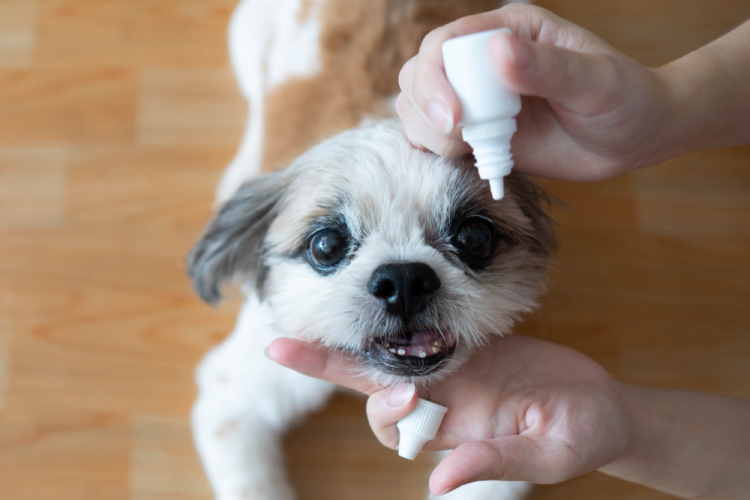
Eye infections happen to Shih Tzu frequently because of glandular secretions which lay on the fur below their eyes unless frequently cleaned.
Build-up of this matter attracts dirt and bacteria which eventually leads to an infection.
Antibacterial eye drops are used when an infection is diagnosed by a veterinarian, along with constant removal of the secretions by the owner until the infection is gone.
Pink eye is a common type of infection seen in this breed, as well as other dog breeds.
Cherry Eye
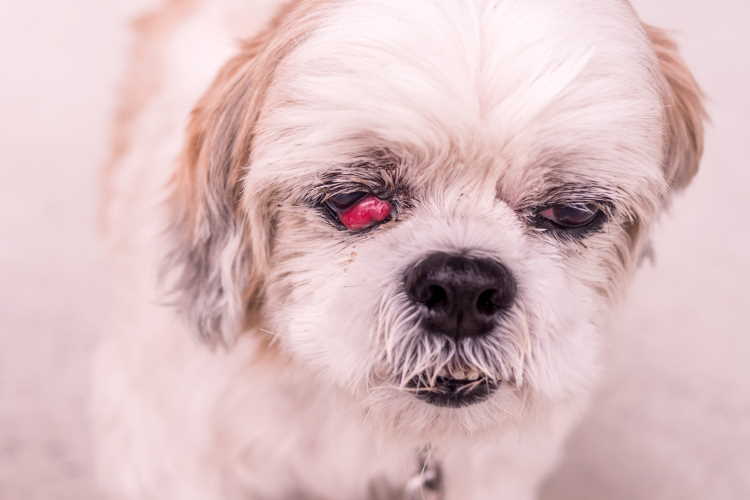
Shih Tzu are also predisposed to experiencing prolapse of the gland of the third eyelid, also referred to as "cherry eye".
Cherry Eye happens when the gland within the third eyelid emerges from its normal spot in the eye and becomes extremely swollen and "cherry" red.
Treatment for this health issue is simply surgical repositioning of the gland.
Proptosis
Proptosis is another eye problem affecting Shih Tzu and other breeds with bulging eyes, short, flattened noses and shallow eye sockets such as the Pug and Boston terrier.
When proptosis occurs, something that is almost always due to a severe trauma to the head, the entire eyeball has become displaced and is not even situated in the eye socket anymore, causing the eyelids to become trapped behind the eye.
Unless emergency treatment is administered, blindness can result as a consequence of restricted blood flow to the injured eye.
One of two things can be done in this case--either put the eye back into the socket or remove the eye if it is too damaged.
Distichiasis & Trichiasis
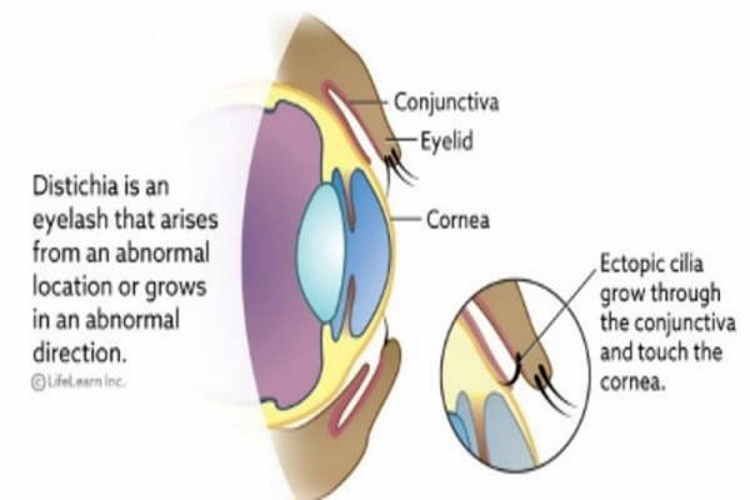
These two words may sound severe, but it basically relates to the eyelashes and hair around the eyes.
Distachiasis is an abnormal eyelash growth, Trichiasis is a hair on the eyelid or nasal fold area, growing in the wrong direction, rubbing against the eye.
Your may see your dog wipe his eyes a lot as these eyelashes will cause irritation.
You can usually see the eyelash affecting your dog and will have to be treated by a veterinarian, whereas a plucked eyelash will only grow back.
Because Shih Tzu eyes are vulnerable to a variety of health issues, they should be always be watched for any signs of abnormality by the owner and taken to the veterinarian at the first sign of distress.
Sources:
Animal Eye Care: Cataracts and Cataract Surgery in Dogs
MSPCA: Corneal Ulcers in Dogs
Ethos Veterinarian Health: Your Pets Ocular Health
Merck Veterinary Manual: Traumatic Proptosis
Comment from one of our readers
Janet from USA :
I just thought you might want to mention on your blog that my husband and I have had success getting rid of the gunk that oozes from most shih tzu's eyes by giving our shih tzu Zoe a teaspoon of organic virgin coconut oil daily. We use to have to clean her eyes daily, sometimes twice, and now we do not have to ever clean them.
